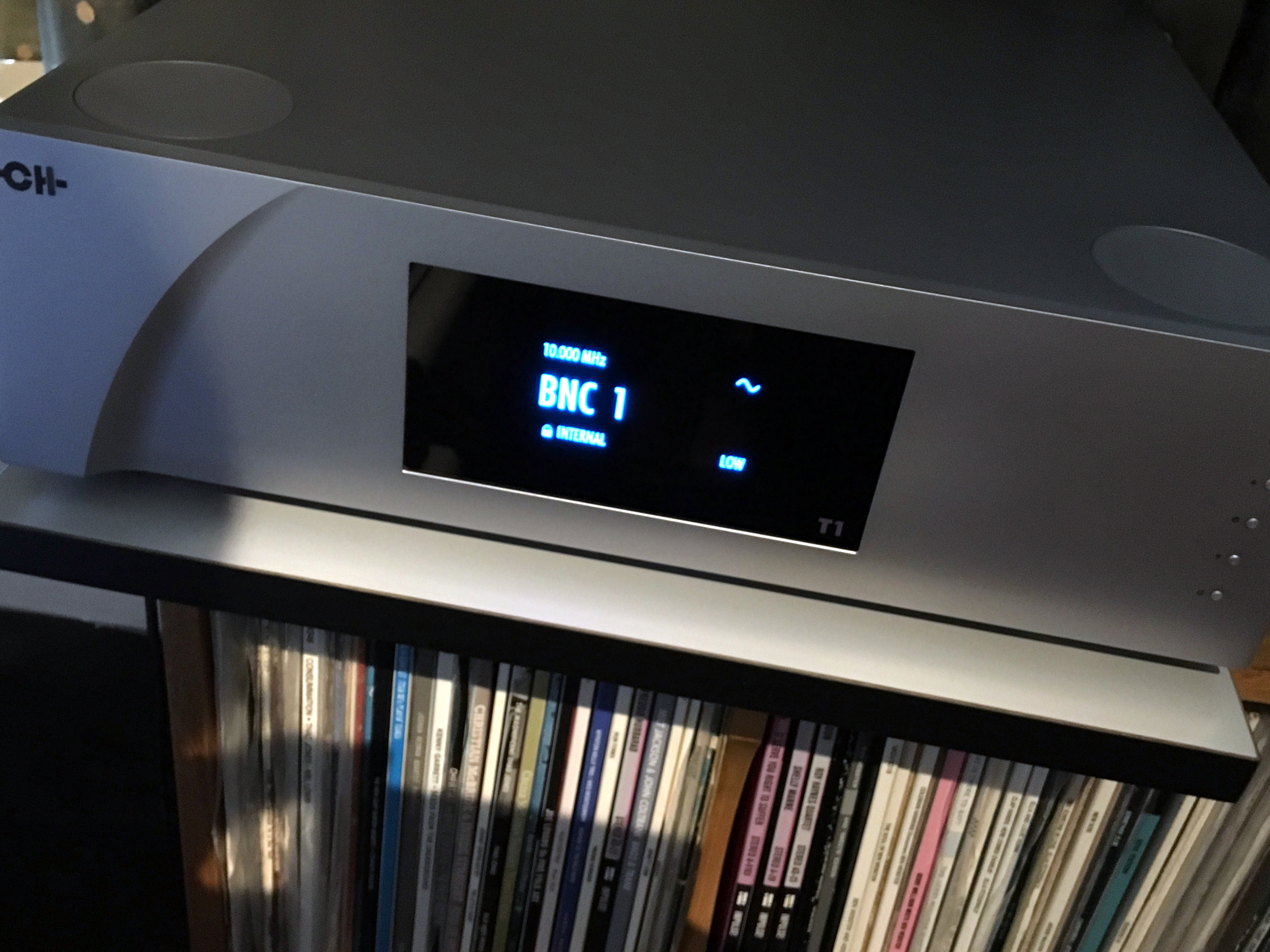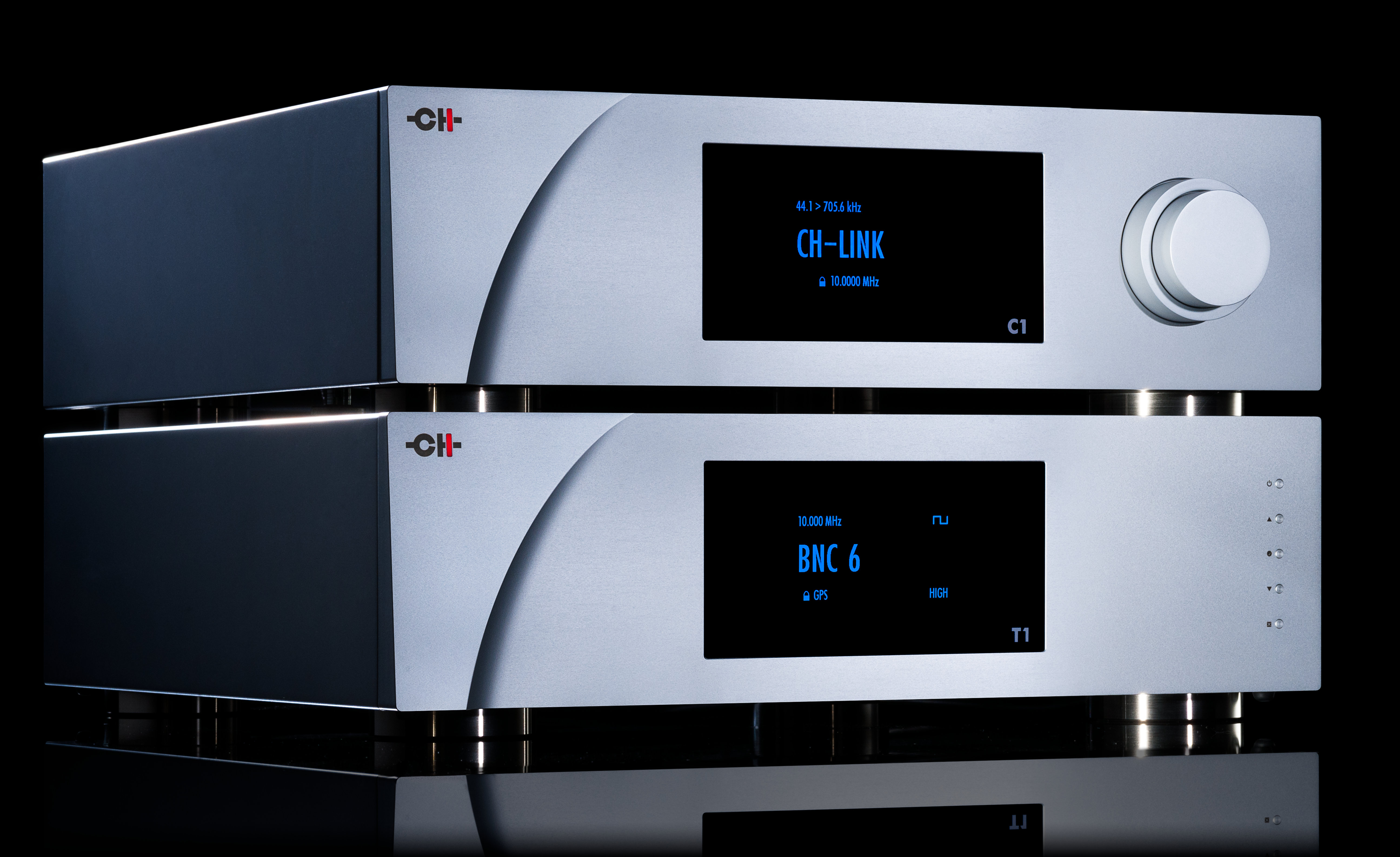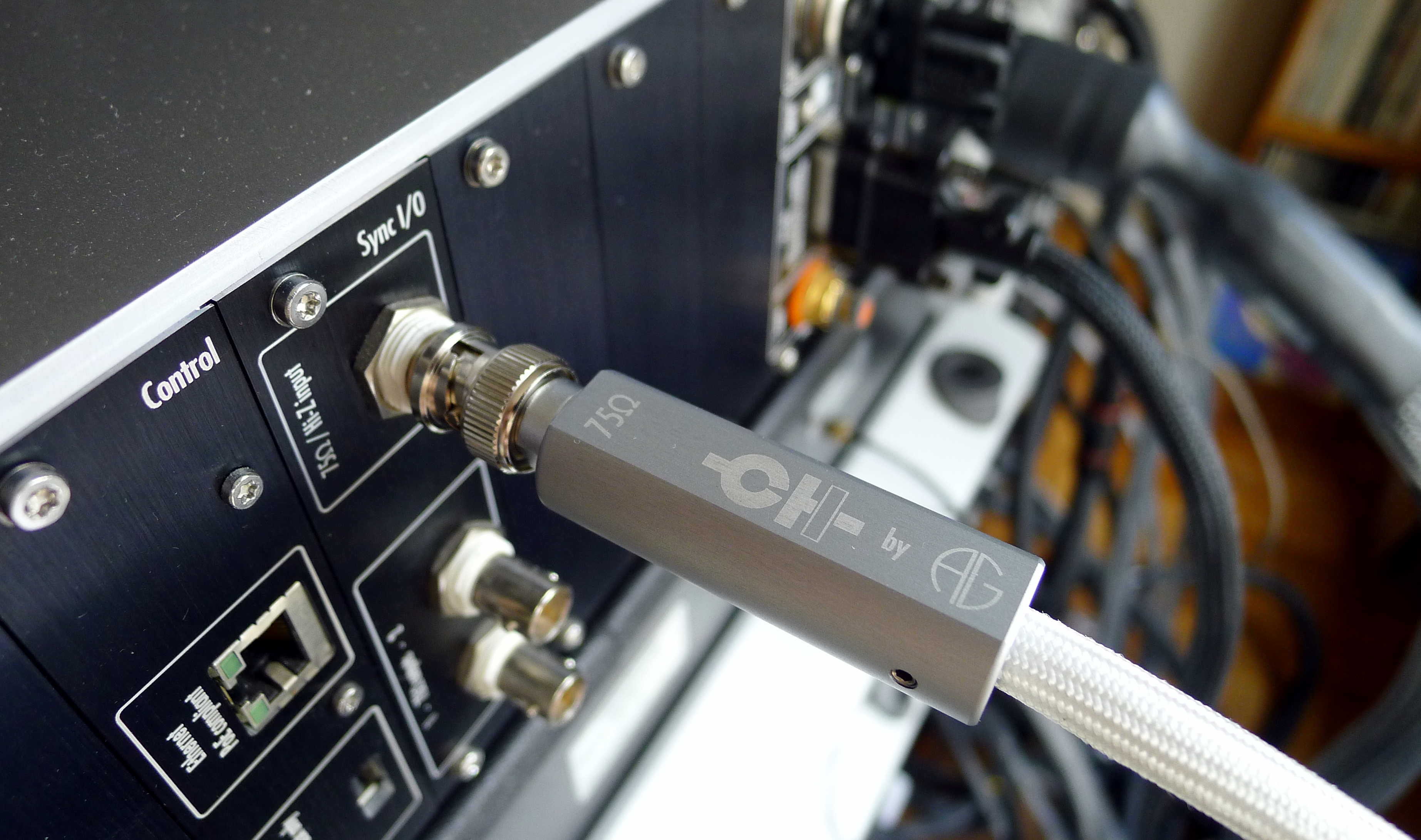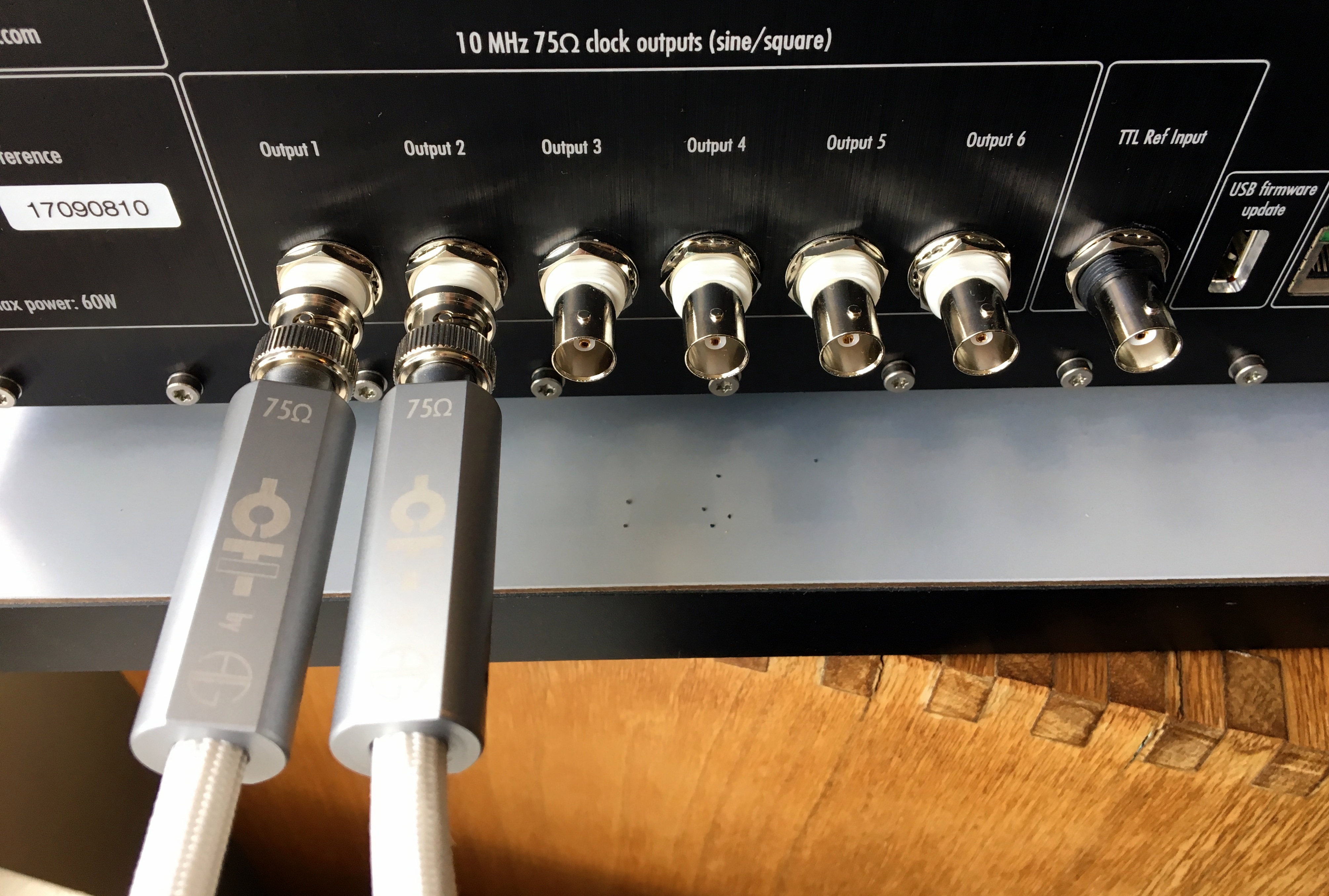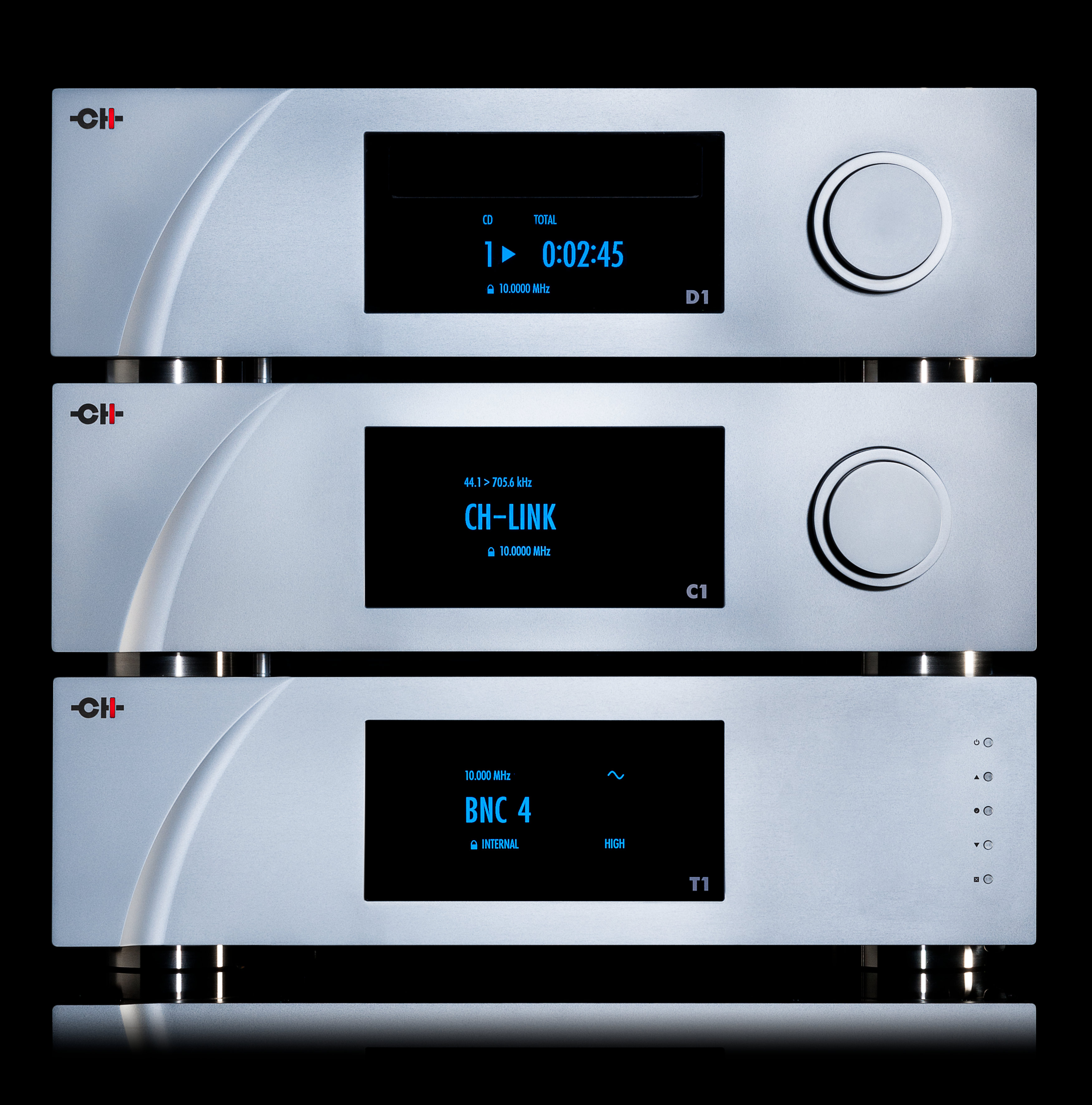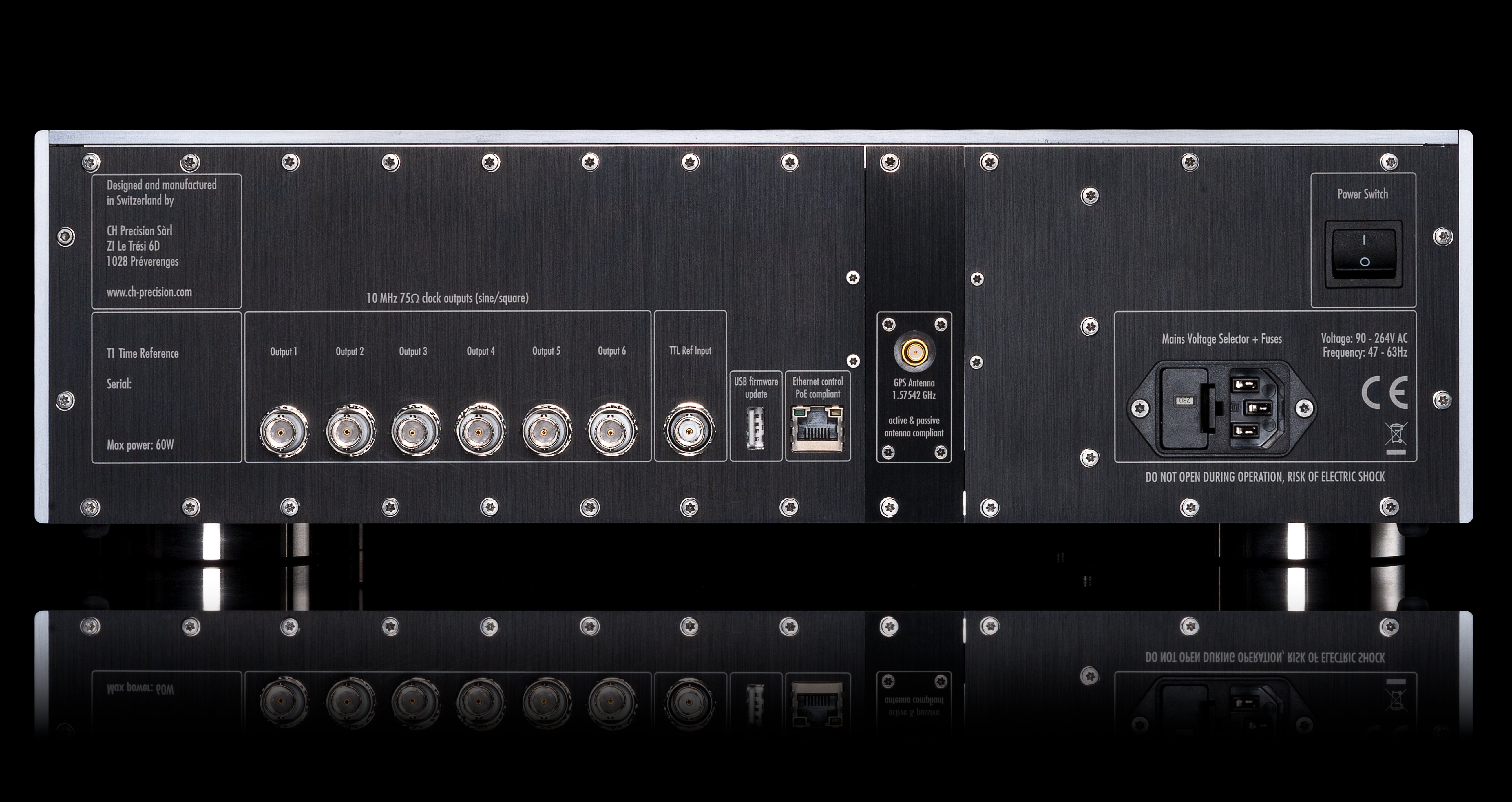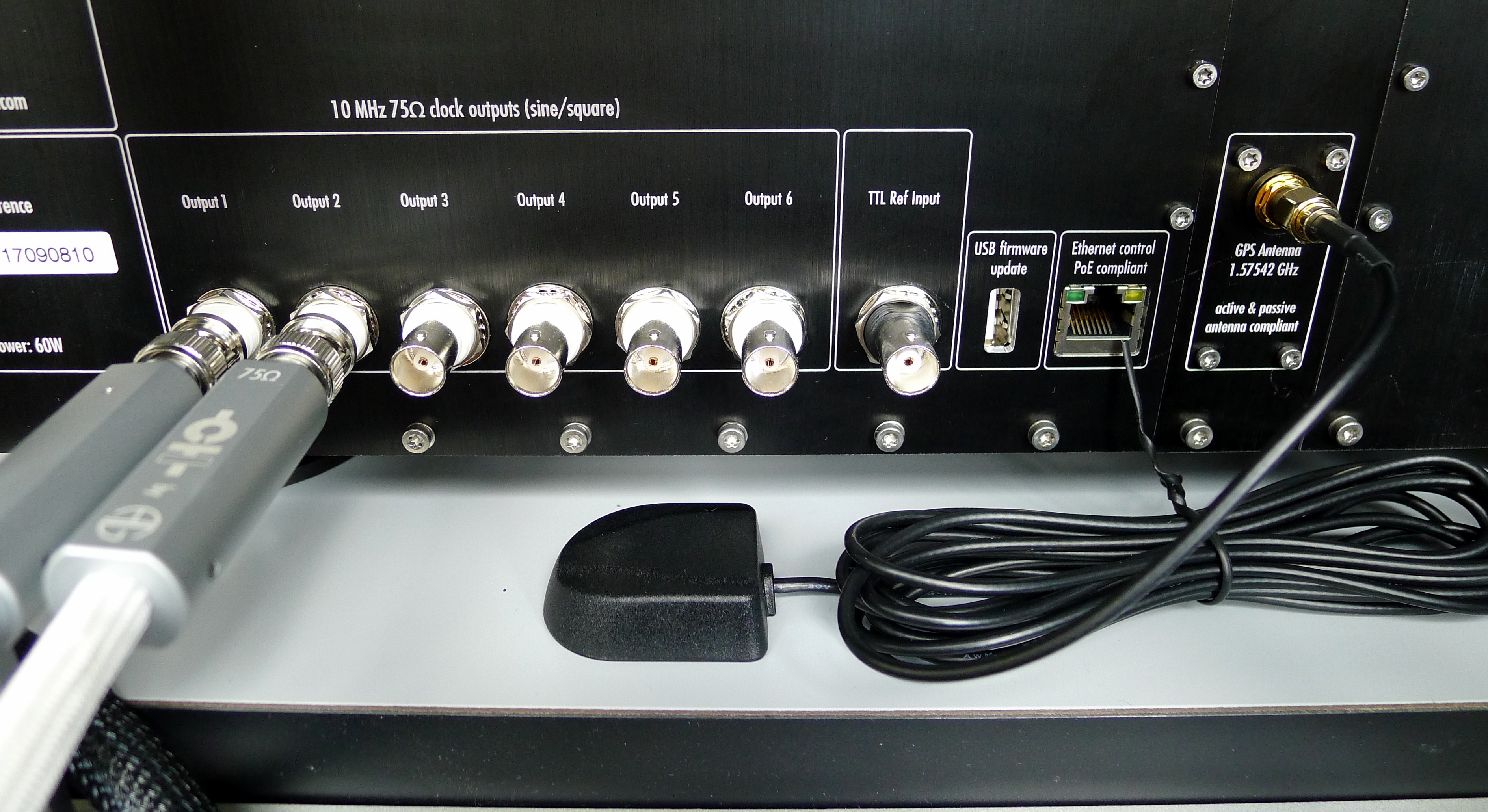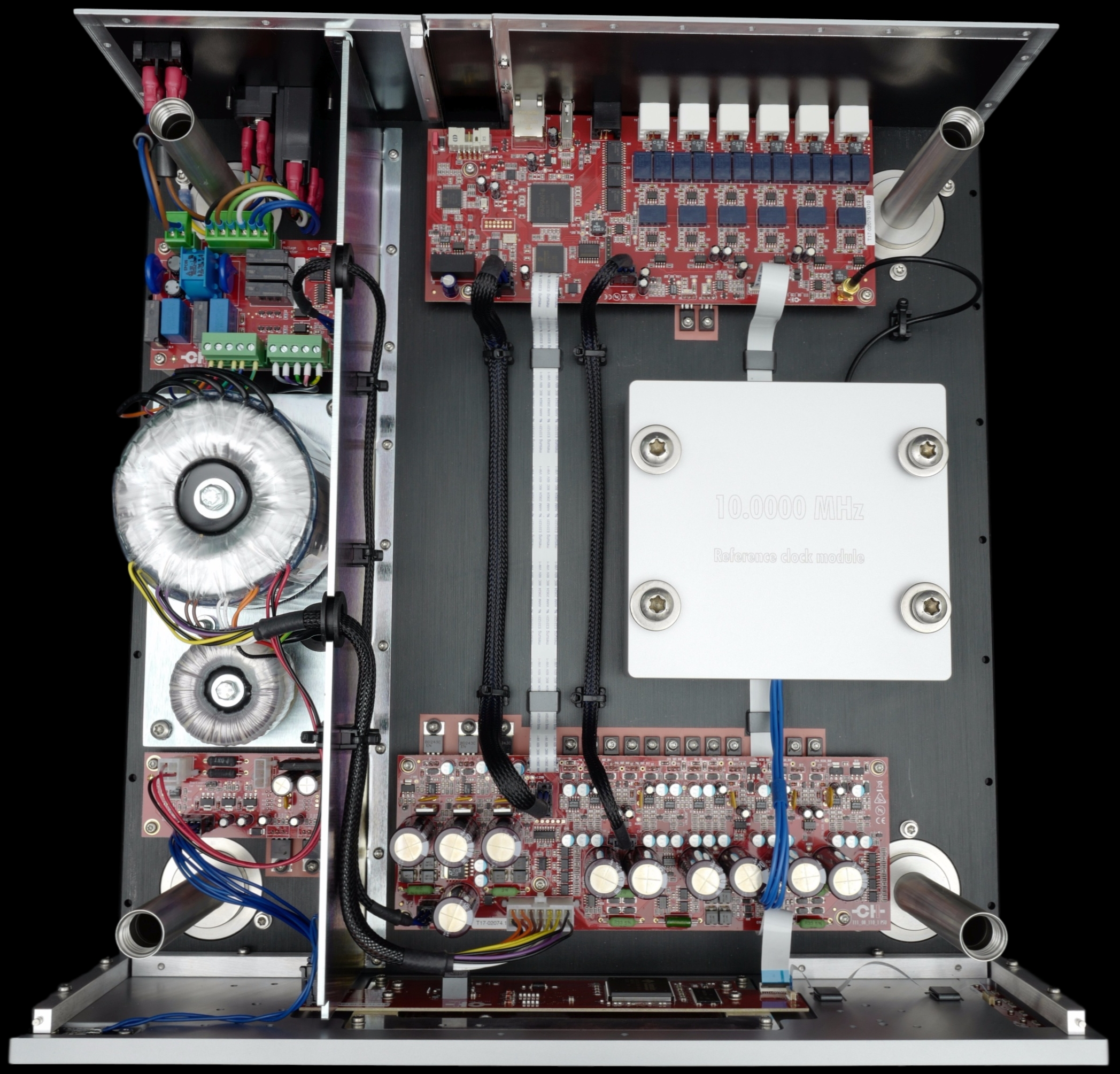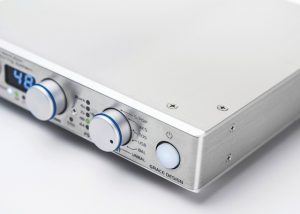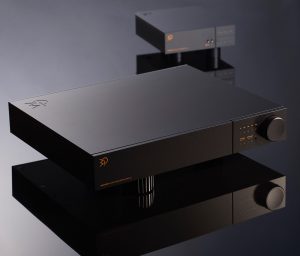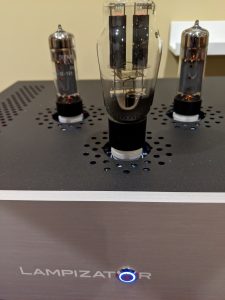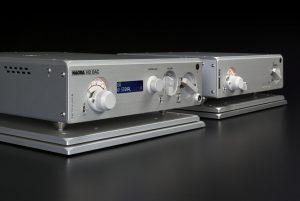"In the future, everyone will be world-famous for 15 minutes." Andy Warhol didn't foresee the internet, but he sure nailed a defining characteristic of how we live today.
You could make a case that master clocks for digital audio had their 15 minutes when they were featured on audio magazine covers—sort of like MQA digital is today. Then they dropped off the cliff. Occasionally you find articles inside, but they are no longer cover worthy.
I confess I was never a fan. I once visited a dealer friend who was hyperventilating about a couple of clocks he had on hand. We did several A/B/x compares. Clearly, they made a difference, but Lynn and I both judged the result veered to the analytical, less musical. End of clock story for me…or so I thought.
Guess what's on my audio rack now? The latest product from CH Precision, the T1 digital clock. How this came about is due to correspondence with my audio pen pal Rahul: "You should request CH to send you their new T1 external clock. Reliable ears have told me it is exquisite!!!" (He always writes like that, with multiple exclamation points.)
Listening
The T1 was delivered with a pair of CH Reference Clock Link cables, a new 75 Ohm BNC cable (MSRP $4500/m and you will need two of them.) I let the T1 burn-in over four days. (Does a clock need burn-in? Probably, as it contains electric circuits. What about the Ref Clock Link wires? Don't know.) Meanwhile, I couldn't resist casually listening. My ear immediately perked up with the T1 in stream.
But I'm getting ahead of myself. Let's back up and start at the beginning. I disengaged the T1 and went back to my baseline, the CH Precision D1 transport + C1 DAC and the unmarked brand BNC cable that came with it. Of course each of these components can be used stand alone, but most listeners would agree that when paired they comprise a formidable, world-class front-end.
Each has its own clock. However, CH recommends using the C1's clock for both components. With digital separates, there must always be no more and no less than one clock master. The rationale is you want the same time signal applied when extracting the bit stream from the CD as when converting it back to analog on output. That's what the BNC cable is for: to carry the clock signal from the C1 to the D1.
The internal clock in the C1 is a highly sophisticated device:
…two high-precision low-drift audio crystal clock oscillators… located only a few cm from the DAC chips. The clocking section has its own dedicated power supply fully decoupled from all noisy digital signals. This critical Masterclock signal is carried to the DAC chips in LVDS (low-voltage differential signaling) form to avoid any cross-talk pollution. In order to be synchronous to the incoming audio signal, these crystal oscillators can be fine-tuned using a voltage controlled feedback (VCXO), computed by a proprietary algorithm. Performances of this "digital phase-locked loop" (digital PLL) is jitter rejection below 0.1 Hz, while frequency tracking is achieved through sub 0.1 PPM correction steps. Phase alignment is also guaranteed with a +/-2.5 us accuracy. When combined with matching CH D1 SACD/CD drive and optional synchronization boards (or a computer source), the C1 can even be configured as the clock master, having the source (either CH D1 or computer) clock enslaved. In such configuration, the jitter is completely removed from the system.
I bolded that last sentence so you wouldn't miss it. With the two-chassis CH digital we're already approaching vanishing levels of jitter.
I've been happily listening to this two-chassis front-end for three years, but now, after just that small taste of the T1, I was having issues. Listening to the LSO String Ensemble doing Britten's Variations on a Theme of Frank Bridge (SACD LSO0792), I was looking at a stage populated with an array of miniature, sharp-edged images. Tone and timbre were parsimoniously doled out. It was tight and I could not tell closely seated instruments apart. Yeah, I was already spoiled.
The CH Reference Clock Link
So, let's begin. First thing I did was swap out the no-name, 75 Ohm BNC cable for a CH Ref Clock Link.
Ahh… Of course, it's the same music—only a healthy dollop of bloom relieves the stingy timbres. A single Ref Clock Link fleshed out images, gave them girth and imparted soft, natural borders. Meanwhile, the stage became less spotty across its width and frequency integration benefited: all of this to the betterment of string tone. Low-end extension seemed to plunge deeper with a lot more heft and potency.
This was no small advance, yet all we did was swap the cable carrying clock information—not even the data stream. (Another cable, the CH-Link, carries the data stream.) I was curious why it made such a difference and made inquiry. Here is what CH has to say:
The quality of the cable is second to none in a clock system. Distortion in the shape and characteristics of the clock signal could result in higher jitter at the receiving end (in the C1 and D1), which would defeat the object of using a low phase-noise clock generator.
The Reference Clock Link is beautifully constructed, with a fancy twist and lock BNC connector of CH design and silver wire conductors from Argento Audio.
Add in the T1
Now for the main course. I ran a Ref Clock Link from the T1 to the D1 and another down to the C1, and followed the setup instructions in the T1 User Manual. Now the transport and DAC became clock slaves: the T1 is the clock master.
Ahh…indeed! Sure, it's the same musical program—only it ain't. Everything has morphed. Suddenly notes don't linger about. They land on the beat with a crisp transient, fully expressed sustain, and then are swept away with shortened decays. Note tails are succinct, nothing lags. Everything's moving faster with a finger-snapping velocity and quickened tempo.
That blended continuousness across the width of the stage? No more. Individual instruments stand out in high relief, starkly contrasting with the deep black background. Usually this kind of spot-lighting and black background appears artificial to me. In this case, it is ameliorated because the musicians still manage to appear together in the same space and time.
On other fronts, macro dynamics attain higher peaks, while the low end has even more bite and growl. Dynamic shifts occur smoothly—no step-like, jerky action. When something happens it is more apparent, you can't miss it. It is similar to the spot-lit images: they are more contrasty. I had no trouble disentangling who is playing at any given moment—the T1 empowers you with X-ray vision.
Where Digital Clocks Diverge
These advances were not too surprising—on par with what you'd expect from an expensive master clock. What sets the T1 apart from the others I've heard is it was not a lopsided advance. I was delighted to find the musical aspects of the performance advanced in sync. As my panelist buddy David put it, "The T1 holds onto the superb musical goodness you had before, and builds on it." Images don't shrink up or tighten. On the contrary, they become more massive and fleshy, there is no loss of body, and they acquire Big Tone. Borders firm up, just not to the degree of being etched. The softness, or what David called "politeness," is gone.
And I love the filigree of delicate overtones in the treble, where a wealth of shimmering detail appears like fancy lace work. Micro dynamics, texture and timbre all move forward and support a newly rich inner life.
Digital Phobia
I will conclude the evaluation with a little story. Some time ago I began a session with the Debussy Sonata for Flute, Viola and Harp, performed by the Trio Leandro (NCA 60158-207 SACD). We were all digging it—only Jonathan wasn't happy. This was with the two-chassis D1 + C1 combo.
I swapped to the famous Chandos LP of the same composition (ABR 1036). Jonathan audibly exhaled and relaxed with the first notes. "That LP shows all the flaws of the CD." Then Dave, grinning, piped up with, "The LP is vivid and alive. It has the right kind of distortion." We all agreed that analog's even-order distortions go down easier on the ear.
I pressed Jonathan to expound on his digital-phobia. He was voluble: digital suffers with tight sound caused by the brick wall filters; the CD doesn't breathe because of pre-ringing; the CD has blurring that precedes the note; finally, the decays are truncated.
A year later, we're looking at the three-chassis CH front-end and I was most anxious to get Jonathan's take. Would it be the Digital Antidote?
Nope. "It doesn't transform digital, but it sounds a lot better. It's moving towards analog." He still had one foot out the door. For the record, those classic digital artifacts don't bother me—at any rate, not like they used to. It was a very long gestation, but digital has arrived, even if it still sounds different than analog.
The Look and Feel
The T1 is a full-size component in the same very large, aluminum box as the other CH gear. Fit-n-finish is luxurious—I wouldn't be surprised if the chassis alone accounts for $9K of the MSRP. CH products are not cheap, but at least you can see where the money is going.
You'll find the front-panel display window and controls familiar as well. The usual CH features are included: the metal spike isolation system with the S-Discs; the firmware upgrade through a USB port; the extensive menu system; etc.
Installation
The T1 went on my TAOC rack between the D1 above and C1 below. It runs quite warm as it contains an OCXO that requires temperature stability, so give it ample shelf space. (We'll talk about the OCXO shortly.)
Configuring the T1 is not difficult. The only questions I had were for Output Waveform and Output Level. When used with the D1 + C1, what settings were recommended? I received this reply:
Our recommendations for use with CH equipment are: Output Waveform: sinewave; Output Level: low level. We specify the low sinewave to maintain electromagnetic emissions to the minimum. This is also why we can turn off the unused outputs.
The GPS Module
All clocks show some drift over the long term. Is there a more stable reference? Yes, up above us in the sky—the ultra-stable cesium clock used in satellites. The GPS plug-in module (available at extra cost) allows the T1 to connect to a satellite. It uses a small antenna (provided) to access the "sky" and lock onto satellite signals. You might have to fiddle with the antenna position to get it to where it can lock. Close to a window is usually good.
T1 with GPS antennae
The GPS module works in conjunction with the OCXO. Processors in the T1 measure the output signal of the OCXO and, if some drift appears over time, correct it by taking the GPS output as a reference.
Conclusion
When the CH Precision T1 Time Reference was announced recently, I didn't pursue it. My previous experience with master clocks was not encouraging. The ones I heard tipped to the analytical and I promptly dismissed the category.
Then an email came from my audio pen pal Rahul, who praised the new T1 and strongly suggested I get one in. Well, thank you, Rahul.
The T1 Time Reference let loose a barrage of detail beyond anything I've heard from digital source. That it is outstanding in purging obscurity meets my expectations for a master clock. But it was not a lopsided advance on the analytical front alone. It was balanced with enhanced timbre, full tone, and especially PRaT. CH went about it the correct way. I'd guesstimate the addition of the third chassis moves the CH front-end forward by about 12%.
Lynn likened the CH T1 to a man's choice in business attire. Do you want to wear a cotton blend, wash-n-wear shirt, or a hand-pressed, 100% cotton shirt, fresh from the laundry?
T1 Time Reference Digital Clock
Retail: $24,700
Reference Clock Link cable
Retail: $4500/m
GPS option
Retail: $3900
CH Precision
Postscript: The Visit
I was fortunate in that not more than a week after receiving the T1, Raphael Pasche, the CH press rep, came to NYC. We met one evening to socialize and spin tunes on my CH system. Before he departed I gave him carte blanche to check out my installation. I was secretly hoping he'd find something to tweak—and he did.
Below are some unpublished CH tips:
P1 Phono. I am using the P1 in Current Mode for my Air Tight OPUS cartridge and its .5mV output. We set the Input Gain to +20dB. Rationale: let the P1 do most of the amplification up front. We tried +15dB and that was good, but +20 was better.
M1 monoblock. Set the M1's Gain control up to +3dB. Then lower the L1 Preamp volume by the same amount (-3dB). The JFET transistor in the M1's first gain stage will see a lower amplitude signal; that allows it to work cleaner.
C1 DAC. Both PCM and DSD Filters were set to Minimum Phase.
Raphael at work
By far, the biggest mod was switching the M1s from Monaural Mode to Passive Bi-amp. Each M1 monoblock contains two amplification modules inside. When you select Monaural Mode, one of the amp modules is simply not used at all. The other amp module then benefits from having the whole power supply to itself. Its output is run to a single set of binding posts.
With Passive Bi-amp Mode, both modules are active and the power supply is shared. Each module delivers 200 watts to its own set of binding posts. With bi-wired speakers, that's 200 watts per set of binding posts. Additionally, it made bi-wire speaker cable connections much easier. (Bi-wiring on a single set of the M1s Argento binding posts is no picnic.)
Then, the next time you drill down on the M1s front-panel menu, you will see that many options have been replicated, affording independent adjustment for each module. For example, we left Global Feedback for amp module 1, which goes to my tweeter, at 0%; module 2, for the midrange/woofer drivers, was set to 10%. This leaves the treble open and increases control over the midrange and upper bass.
Similarly, the Gain could be tweaked. For example, if I wanted to shift tonal balance to boost the midrange/upper bass, I could increase module 2 in +.5dB increments, leaving module 1 alone. This is great! Previously I used to fiddle around with a grab bag of tweaks, including room acoustic products, platforms, footers, or wires. Now I had a very powerful tool that was built-in—the M1s menu system—and it doesn't alter the essential voicing of the amp.
Whew, that's a lot. Passive Bi-amp opens up a plethora of possibilities for tailoring the sound of bi-wired speakers.
Manufacturer's Technical Statement
For those who are interested, Raphael emailed me this (edited) T1 engineering summary:
The T1 is a clock generator that can connect any pieces of equipment capable of syncing to a 10MHz clock signal. It has 6 individual outputs, each capable of outputting a square or sinewave signal with low or high amplitude. We provide these options so the T1 is as universal as possible with pieces of equipment from many brands.
Despite looking like a digital signal, inside the T1 the clock signals are treated as analog signals, buffered by analog linear buffers. This ensures the lowest noise, highest linearity and lowest phase noise. (Phase noise is the frequency domain representation of rapid, short-term, random fluctuations in the phase of a waveform, caused by time domain instabilities – "jitter").
The heart of the T1 is an oven controlled oscillator (OCXO). In essence, an OCXO is an oscillator encapsulated inside a dual wall enclosure for thermal insulation. The temperature inside the enclosure is monitored and regulated for constancy. Temperature variations are directly proportional to changes in the frequency of the signal generated by the oscillator.
T1 Interior View
The OCXO is mounted on a printed circuit board which is assembled inside a heavy aluminum block. The block is mounted on Alpha gel pads. The block dimensions and weight have been meticulously worked out to provide:
1) a third level of thermal insulation (the OCXO is touching the aluminum block via a thermal compound)
2) reduction of the susceptibility to mechanical vibrations from frequencies below the audio band. (The combination of the dimensions and weight of the block and the properties of the Alpha gel pad the block is mounted onto are key to work out at what frequency the whole mechanical assembly could oscillate at.) Parasitic vibrations can come from the chassis of the unit (ground vibrations) but can also be airborne. (The T1 enclosure, the aluminum block as well as the OCXO dual wall enclosure act as airborne vibration protection.) An oscillator generates an electrical signal at a precise frequency from the mechanical resonance of a vibrating crystal of piezoelectric material. If the oscillator is subject to mechanical vibrations, it will alter the output signal frequency and add jitter.
An OCXO requires a power supply. The quality of the electrical signal powering the OCXO is just as crucial as thermal and mechanical considerations. Therefore, we opted for belt and braces power supplies. The mains voltage is filtered right at the input of the unit. It reaches an oversized mains toroidal transformer. There are many secondary
windings for the various parts of the design to ensure a galvanic isolation between the various sections of the T1. The signal is regulated three times (there are three regulation system in series with each other): a capacitor multiplier circuit, followed by a voltage series regulator and finally a shunt current regulator. This ensures the maximum immunity and the cleanest, lowest noise power supply.
In addition, there are three power supplies inside the T1:
1) the power supply for the OXCO itself
2) a second power supply for the crucial analog buffer directly following the OCXO
3) a third power supply for the 6 buffers dedicated to the 6 outputs
However, there is one thing that cannot be controlled with the above considerations: the slow frequency drift of the OCXO output signal over time. Every oscillator in the world will show frequency drift with time. When I say slow drift, I am talking drift within months/years. In order to control and compensate for the slow drift (also called aging), some manufacturers have implemented a rubidium atomic clock. Using the intensity of a rubidium discharge lamp, the oscillator output frequency can be controlled.
We decided not to use a rubidium clock in the T1 for the following reasons:
1) There is a more accurate solution called the cesium atomic clock
2) We do not want to impose on our customers a radioactive element in their living room
Cesium atomic clocks, although the most accurate time and frequency standards, have two major problems: price and size. The T1 would cost a lot more if we had designed in a cesium atomic clock.
However, there is a cesium solution that can be more easily implemented. Where do you find cesium atomic clocks most often? Right above our heads, in satellites.
With the T1, we have introduced the GPS option. The GPS option uses a similar satellite navigation system as you find in cars and boats. It receives a 1PPS (pulse per second) signal, directly generated by the satellites cesium clocks.
The satellite signal that appears at the input of the T1 has quite a high amount of jitter, making it unusable as such. However, using complex averaging algorithms, we can extract the most accurate and lowest slow drift signal possible. (The longer the T1 is left on, the more accurate it will be.)
In addition, progress in space technologies means that the T1 will always be using the best technology as new satellites get launched into space. We like to joke in saying that we use "rocket science" in the T1!




